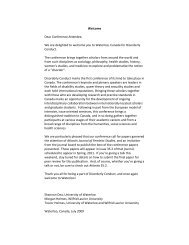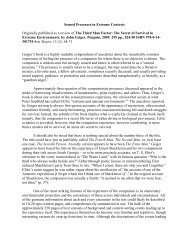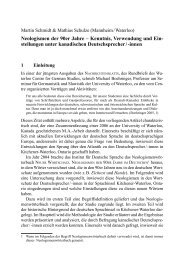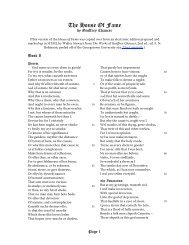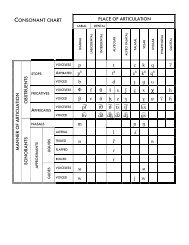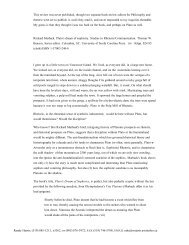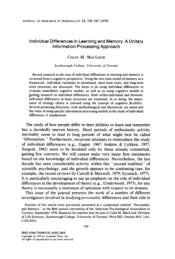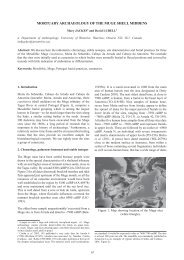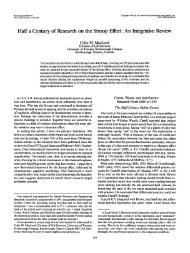The mid seventeenth century collapse of Iroquoian Ontario:
The mid seventeenth century collapse of Iroquoian Ontario:
The mid seventeenth century collapse of Iroquoian Ontario:
You also want an ePaper? Increase the reach of your titles
YUMPU automatically turns print PDFs into web optimized ePapers that Google loves.
M. JackeS<br />
356<br />
<strong>of</strong> live-born children within the reproductive life <strong>of</strong> an average woman) <strong>of</strong> around 5-6 accord<br />
with the ethnohistorical and historical evidence. How could Ossossané, but especially<br />
Grimsby, have had such high fertility levels? It became necessary to concentrate on fertility<br />
as a way <strong>of</strong> understanding this paradox.<br />
Higher fertility just before the intensification <strong>of</strong> agriculture (derived from Jackes, 1986,<br />
p. 38) would be a reasonable assumption and I began to work on developing a method which<br />
would allow a comparative study <strong>of</strong> fertility levels during the late Mesolithic – early Neolithic<br />
in Western Europe in an attempt to understand if, and exactly when, fertility levels might<br />
have changed (Jackes and Meiklejohn 2008 represents the last <strong>of</strong> a series <strong>of</strong> papers on this<br />
question). <strong>The</strong> problem <strong>of</strong> Grimsby was set to one side until the method was developed and<br />
fully tested, but it remained <strong>of</strong> primary interest.<br />
A comparative approach to discerning large-scale trends, such as alterations in fertility<br />
levels in association with subsistence changes, or following European contact, requires that<br />
the sites used be suitable components <strong>of</strong> such a test, that they represent a biological reality. In<br />
the past, palaeodemographers accepted determinations <strong>of</strong> excessively high mortality<br />
(drawing criticism such as that <strong>of</strong> Howell, 1982), and it is just as important that palaeodemographers<br />
do not accept demographic values which imply unrealistically high fertility 9 . When<br />
demographic estimators fall above certain levels, the demographer is implicitly stating that<br />
the average woman has 12 or more live-born children in that society (a TFR <strong>of</strong> 12 is the highest<br />
recorded, Eaton, Mayer, 1953). Obviously, maximum human fertility, as distinct from the TFR,<br />
is above 12. Women have had more than 12 children; in exceptional cases, many more.<br />
Nevertheless, the exceptional is not relevant to palaeodemographic analysis and we must<br />
deal with the most probable and the average, not with the least probable exceptions. <strong>The</strong><br />
probability <strong>of</strong> becoming pregnant within a year (that is, twelve reproductive cycles) is 90% or<br />
less, even in the 20-25 age group and even under the most favourable conditions (J<strong>of</strong>fe 2000;<br />
Bongaarts, 1975; Dunson et al., 2004; te Velde et al., 2000). Fertility determinants and<br />
constraints have been discussed previously, in general terms and with particular reference to<br />
<strong>Iroquoian</strong> <strong>Ontario</strong> in the 17th <strong>century</strong> (Jackes, 1994; Jackes et al., in press; Jackes, Meiklejohn,<br />
2004; 2008). <strong>The</strong> whole issue is contentious, as can be seen by following merely one set <strong>of</strong><br />
papers, focusing on lactational amenorrhea, culminating in the comments in Konner et al.<br />
(1985): nevertheless it is clear that several <strong>of</strong> the characteristics <strong>of</strong> <strong>Iroquoian</strong> society<br />
constrained fertility (Jackes, 1994).<br />
Engelbrecht (1987) concluded that the fertility <strong>of</strong> the New York Iroquois was so low that<br />
adoption <strong>of</strong> war captives, especially women and children, was a mechanism for maintaining<br />
population levels. <strong>The</strong> French did indeed see low numbers as a problem for the Iroquois:<br />
Chaumonot (2002, p. 34) told the Iroquois that if they were to maintain marital stability, they<br />
would not have to resort to war as a method <strong>of</strong> increasing their family size. <strong>The</strong> Jesuits also<br />
complained specifically about the Neutral in regard to marital instability (JR, 8, p. 151).<br />
9. As discussed in Jackes and Meiklejohn (2004) the value P, which is actually 15 q 5 , proposed by Bocquet-Appel<br />
(2002) and Bocquet-Appel and Naji (2006), implies fertility levels over 12 when it reaches about .350.



